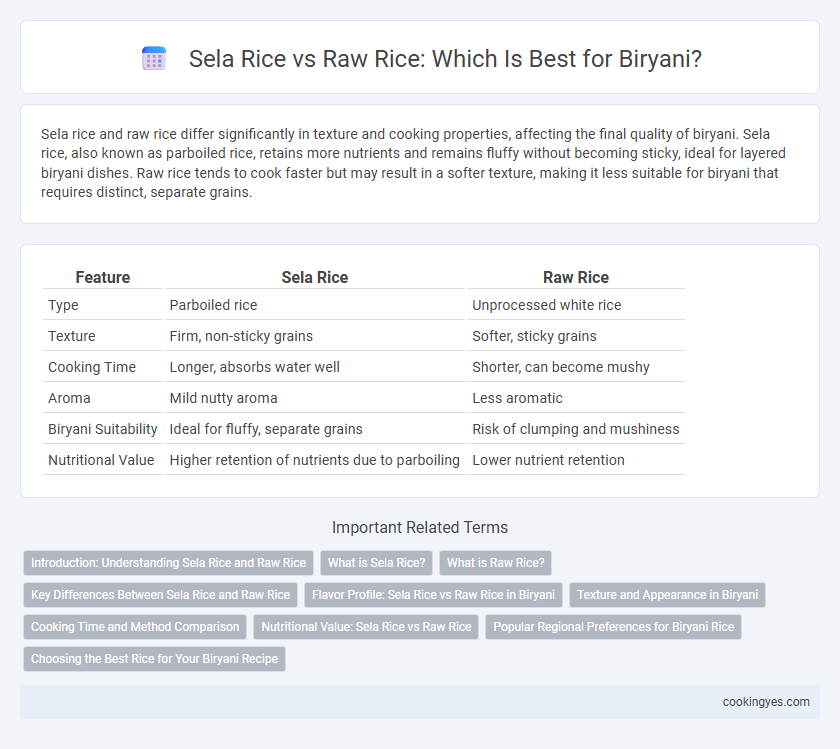Sela rice and raw rice differ significantly in texture and cooking properties, affecting the final quality of biryani. Sela rice, also known as parboiled rice, retains more nutrients and remains fluffy without becoming sticky, ideal for layered biryani dishes. Raw rice tends to cook faster but may result in a softer texture, making it less suitable for biryani that requires distinct, separate grains.
Table of Comparison
| Feature | Sela Rice | Raw Rice |
|---|---|---|
| Type | Parboiled rice | Unprocessed white rice |
| Texture | Firm, non-sticky grains | Softer, sticky grains |
| Cooking Time | Longer, absorbs water well | Shorter, can become mushy |
| Aroma | Mild nutty aroma | Less aromatic |
| Biryani Suitability | Ideal for fluffy, separate grains | Risk of clumping and mushiness |
| Nutritional Value | Higher retention of nutrients due to parboiling | Lower nutrient retention |
Introduction: Understanding Sela Rice and Raw Rice
Sela rice, also known as parboiled rice, undergoes steaming before milling, which preserves nutrients and enhances grain firmness, making it ideal for biryani's layered texture. Raw rice is unprocessed and retains its natural aroma but may result in a less fluffy biryani if overcooked. Choosing sela rice contributes to perfectly separate grains and a richer flavor profile in traditional biryani recipes.
What is Sela Rice?
Sela rice, also known as parboiled rice, is a type of rice that undergoes partial boiling in the husk, enhancing its texture and nutritional value. This process results in grains that are firmer, less sticky, and more aromatic compared to raw rice, making Sela rice ideal for biryani dishes that require distinct, separate grains. Its ability to absorb spices and retain shape during cooking ensures a flavorful and visually appealing biryani.
What is Raw Rice?
Raw rice refers to unmilled paddy grains that retain the outer husk and bran layers, offering a firmer texture and distinct aroma essential for authentic biryani. Unlike sela rice, which is parboiled and partially boiled before milling, raw rice preserves more natural nutrients and absorbs spices more effectively during cooking. This results in biryanis with a fluffier grain separation and enhanced flavor intensity favored by traditional recipes.
Key Differences Between Sela Rice and Raw Rice
Sela rice, also known as parboiled rice, undergoes a unique soaking, steaming, and drying process that retains more nutrients and results in a firmer, less sticky texture ideal for biryani. Raw rice, in contrast, is milled directly without parboiling, making it softer and more prone to clumping when cooked. The firmer grains of sela rice hold their shape and absorb flavors better, enhancing the overall biryani experience compared to the softer texture of raw rice.
Flavor Profile: Sela Rice vs Raw Rice in Biryani
Sela rice, known for its parboiled processing, offers a nutty flavor and firm texture that enhances biryani's rich, aromatic spices, preventing the dish from becoming mushy. Raw rice, typically aromatic varieties like Basmati, provides a delicate fragrance and softer texture, allowing the spices to infuse more subtly while preserving individual grain separation. Choosing sela rice results in a more robust flavor profile and distinct grain integrity, whereas raw rice emphasizes aromatic subtlety and tenderness in biryani.
Texture and Appearance in Biryani
Sela rice, also known as parboiled rice, retains more nutrients and has a firmer texture that makes it ideal for biryani, as it remains separate and fluffy after cooking. Raw rice tends to be softer and stickier, which can result in a less distinct grain separation and a heavier appearance in biryani. The golden hue of sela rice enhances the visual appeal, creating a vibrant and appetizing biryani presentation.
Cooking Time and Method Comparison
Sela rice, also known as parboiled rice, cooks faster than raw rice due to its partially boiled processing, which allows it to absorb water quickly and cook evenly, making it ideal for biryani requiring precise texture. Raw rice demands longer soaking and cooking times, which can affect the biryani's overall moisture balance and grain separation if not monitored carefully. Using sela rice ensures fluffy, non-sticky grains with less chance of overcooking, while raw rice offers a softer texture but requires vigilant timing and water control during the biryani preparation.
Nutritional Value: Sela Rice vs Raw Rice
Sela rice, also known as parboiled rice, retains more nutrients such as vitamins B1, B3, and iron compared to raw rice due to its steaming process before milling. This process enhances the nutritional profile of sela rice, making it a healthier choice for biryani by providing higher fiber content and better digestion. Raw rice, while commonly used, tends to lose some essential nutrients during milling and lacks the enriched nutritional benefits found in sela rice.
Popular Regional Preferences for Biryani Rice
Sela rice, known for its parboiled grains, is highly favored in South Asian regions like Pakistan and Bangladesh for biryani due to its firm texture and ability to remain separate after cooking. Raw basmati rice, prized in North Indian and Hyderabadi biryanis, delivers a fragrant aroma and softer grain texture that absorbs spices deeply. Regional preferences hinge on texture and flavor profile, with sela rice preferred for a drier, grain-separated dish and raw rice for a more aromatic, moist biryani experience.
Choosing the Best Rice for Your Biryani Recipe
Sela rice, also known as parboiled rice, offers a firmer texture and enhanced aroma, making it ideal for biryani as it absorbs spices well without becoming mushy. Raw rice, such as traditional basmati, provides a delicate fragrance and fluffier grain separation which is preferred for authentic biryani recipes. Selecting Sela rice ensures durability in cooking, while raw basmati rice delivers a lighter, aromatic finish, so the choice depends on the desired texture and flavor intensity in your biryani.
Sela Rice vs Raw Rice for Biryani Infographic

 cookingyes.com
cookingyes.com